The Research Field of Meat Preservation: A Scientometric and Visualization Analysis Based on the Web of Science
Abstract
:1. Introduction
2. Materials and Methods
2.1. Data Sources and Search Strategy
2.2. Software Used
3. Results and Discussion
3.1. The Field of Meat Preservation Research
3.2. Annual Volume of Articles and Citation Trend
3.3. Meat Preservation Research among Countries and Institutions
3.4. Keywords in Meat Preservation Research
3.5. Co-Citation in Meat Preservation Research
3.6. Knowledge Structure Framework in the Field of Meat Preservation
3.7. Trends and Outlook of Meat Preservation
3.7.1. New Packaging
Biodegradable, Edible Packaging
Active Antibacterial Packaging
Smart Packaging
3.7.2. New Preservation Technology
Nano-Emulsion Composite Coating Technology
Physical Sterilization Technology
Active Functional Water
4. Conclusions
Author Contributions
Funding
Data Availability Statement
Conflicts of Interest
References
- ur Rahman, U.; Sahar, A.; Ishaq, A.; Aadil, R.M.; Zahoor, T.; Ahmad, M.H. Advanced meat preservation methods: A mini review. J. Food Saf. 2018, 38, e12467. [Google Scholar] [CrossRef]
- Zhao, S.; Li, N.; Li, Z.; He, H.; Zhao, Y.; Zhu, M.; Wang, Z.; Kang, Z.; Ma, H. Shelf life of fresh chilled pork as affected by antimicrobial intervention with nisin, tea polyphenols, chitosan, and their combination. Int. J. Food Prop. 2019, 22, 1047–1063. [Google Scholar] [CrossRef]
- Ritchie, H.; Roser, M. Meat and Dairy Production; OurWorldInData: Oxford, UK, 2017. [Google Scholar]
- Rudy, M.; Kucharyk, S.; Duma-Kocan, P.; Stanisławczyk, R.; Gil, M. Unconventional methods of preserving meat products and their impact on health and the environment. Sustainability 2020, 12, 5948. [Google Scholar] [CrossRef]
- Troy, D.J.; Ojha, K.S.; Kerry, J.P.; Tiwari, B.K. Sustainable and consumer-friendly emerging technologies for application within the meat industry: An overview. Meat Sci. 2016, 120, 2–9. [Google Scholar] [CrossRef]
- Gómez, I.; Janardhanan, R.; Ibañez, F.C.; Beriain, M.J. The effects of processing and preservation technologies on meat quality: Sensory and nutritional aspects. Foods 2020, 9, 1416. [Google Scholar] [CrossRef]
- Ben Akacha, B.; Michalak, M.; Najar, B.; Venturi, F.; Taglieri, I.; Kačániová, M.; Ben Saad, R.; Mnif, W.; Garzoli, S.; Ben Hsouna, A. Recent Advances in the Incorporation of Polysaccharides with Antioxidant and Antibacterial Functions to Preserve the Quality and Shelf Life of Meat Products. Foods 2023, 12, 1647. [Google Scholar] [CrossRef]
- Zhou, G.; Xu, X.; Liu, Y. Preservation technologies for fresh meat–A review. Meat Sci. 2010, 86, 119–128. [Google Scholar] [CrossRef]
- Chipley, J.R. Sodium benzoate and benzoic acid. In Antimicrobials in Food; CRC Press: Boca Raton, FL, USA, 2020; pp. 41–88. [Google Scholar]
- Ray, B.; Bhunia, A. Fundamental Food Microbiology; CRC Press: Boca Raton, FL, USA, 2007. [Google Scholar]
- Smaoui, S.; Hlima, H.B.; Braïek, O.B.; Ennouri, K.; Mellouli, L.; Khaneghah, A.M. Recent advancements in encapsulation of bioactive compounds as a promising technique for meat preservation. Meat Sci. 2021, 181, 108585. [Google Scholar] [CrossRef]
- Jiao, X.; Xie, J.; Du, H.; Bian, X.; Wang, C.; Zhou, L.; Wen, Y. Antibacterial smart absorbent pad with Janus structure for meat preservation. Food Packag. Shelf Life 2023, 37, 101066. [Google Scholar] [CrossRef]
- Delgado-Pando, G.; Ekonomou, S.I.; Stratakos, A.C.; Pintado, T. Clean label alternatives in meat products. Foods 2021, 10, 1615. [Google Scholar] [CrossRef]
- Guerrero, A.; Ferrero, S.; Barahona, M.; Boito, B.; Lisbinski, E.; Maggi, F.; Sañudo, C. Effects of active edible coating based on thyme and garlic essential oils on lamb meat shelf life after long-term frozen storage. J. Sci. Food Agric. 2020, 100, 656–664. [Google Scholar] [CrossRef]
- Nkosi, D.V.; Bekker, J.L.; Hoffman, L.C. The use of organic acids (Lactic and acetic) as a microbial decontaminant during the slaughter of meat animal species: A review. Foods 2021, 10, 2293. [Google Scholar] [CrossRef]
- Cegielka, A. “Clean label” as one of the leading trends in the meat industry in the world and in Poland-a review. Rocz. Państwowego Zakładu Hig. 2020, 71, 1. [Google Scholar]
- Asioli, D.; Aschemann-Witzel, J.; Caputo, V.; Vecchio, R.; Annunziata, A.; Næs, T.; Varela, P. Making sense of the “clean label” trends: A review of consumer food choice behavior and discussion of industry implications. Food Res. Int. 2017, 99, 58–71. [Google Scholar] [CrossRef]
- Zhang, X.-L.; Zheng, Y.; Xia, M.-L.; Wu, Y.-N.; Liu, X.-J.; Xie, S.-K.; Wu, Y.-F.; Wang, M. Knowledge domain and emerging trends in vinegar research: A bibliometric review of the literature from WoSCC. Foods 2020, 9, 166. [Google Scholar] [CrossRef]
- Chen, C. Science mapping: A systematic review of the literature. J. Data Inf. Sci. 2017, 2, 1–40. [Google Scholar] [CrossRef]
- Kirby, A. Exploratory Bibliometrics: Using VOSviewer as a Preliminary Research Tool. Publications 2023, 11, 10. [Google Scholar] [CrossRef]
- Wang, N.; Tang, G.; Jiang, B.; He, Z.; He, Q. The development of green enterprises: A literature review based on VOSviewer and Pajek. Aust. J. Manag. 2023, 48, 204–234. [Google Scholar] [CrossRef]
- Melo, A.M.D.; Almeida, F.L.C.; Cavalcante, A.M.D.M.; Ikeda, M.; Ribani, R.H. Garcinia brasiliensis fruits and its by-products: Antioxidant activity, health effects and future food industry trends—A bibliometric review. Trends Food Sci. Technol. 2021, 112, 325–335. [Google Scholar] [CrossRef]
- Lu, X.; Lu, C.; Yang, Y.; Shi, X.; Wang, H.; Yang, N.; Yang, K.; Zhang, X. Current Status and Trends in Peptide Receptor Radionuclide Therapy in the Past 20 Years (2000–2019): A Bibliometric Study. Front. Pharmacol. 2021, 12, 624534. [Google Scholar] [CrossRef]
- Chen, C.M. CiteSpace II: Detecting and visualizing emerging trends and transient patterns in scientific literature. J. Am. Soc. Inf. Sci. Technol. 2006, 57, 359–377. [Google Scholar] [CrossRef]
- Chen, C. Searching for intellectual turning points: Progressive knowledge domain visualization. Proc. Natl. Acad. Sci. USA 2004, 101, 5303–5310. [Google Scholar] [CrossRef]
- Chen, C.; Leydesdorff, L. Patterns of connections and movements in dual-map overlays. J. Assoc. Inf. Sci. Technol. 2014, 65, 334–351. [Google Scholar] [CrossRef]
- Chen, C.; Dubin, R.; Kim, M.C. Emerging trends and new developments in regenerative medicine: A scientometric update (2000–2014). Expert Opin. Biol. Ther. 2014, 14, 1295–1317. [Google Scholar] [CrossRef]
- Kuzior, A.; Sira, M. A Bibliometric Analysis of Blockchain Technology Research Using VOSviewer. Sustainability 2022, 14, 8206. [Google Scholar] [CrossRef]
- Liao, K.; Lv, P.; Wei, S.; Fu, T. A scientometric review of residential segregation research: A CiteSpace-based visualization. Sustainability 2022, 15, 448. [Google Scholar] [CrossRef]
- Meng, L.; Wen, K.H.; Brewin, R.; Wu, Q. Knowledge Atlas on the Relationship between Urban Street Space and Residents’ Health—A Bibliometric Analysis Based on VOSviewer and CiteSpace. Sustainability 2020, 12, 2384. [Google Scholar] [CrossRef]
- Núez-Merino, M.; Maqueira-Marín, J.M.; Moyano-Fuentes, J.; Martínez-Jurado, P.J. Information and digital technologies of Industry 4.0 and Lean supply chain management: A systematic literature review. Int. J. Prod. Res. 2020, 58, 5034–5061. [Google Scholar] [CrossRef]
- Wu, H.; Li, Y.; Tong, L.; Wang, Y.; Sun, Z. Worldwide research tendency and hotspots on hip fracture: A 20-year bibliometric analysis. Arch. Osteoporos. 2021, 16, 73. [Google Scholar] [CrossRef]
- Shen, C.; Wei, M.; Sheng, Y. A bibliometric analysis of food safety governance research from 1999 to 2019. Food Sci. Nutr. 2021, 9, 2316–2334. [Google Scholar] [CrossRef]
- Van Eck, N.J.; Waltman, L. Manual for VOSviewer Version 1.6; Leiden University: Leiden, The Netherlands, 2021. [Google Scholar]
- Borzi, F.; Torrieri, E.; Wrona, M.; Nerín, C. Polyamide modified with green tea extract for fresh minced meat active packaging applications. Food Chem. 2019, 300, 125242. [Google Scholar] [CrossRef]
- Xavier, L.O.; Sganzerla, W.G.; Rosa, G.B.; Rosa, C.G.D.; Agostinetto, L.; Veeck, A.P.D.L.; Bretanha, L.C.; Micke, G.A.; Costa, M.D.; Bertoldi, F.C. Chitosan packaging functionalized with Cinnamodendron dinisii essential oil loaded zein: A proposal for meat conservation. Int. J. Biol. Macromol. 2021, 169, 183–193. [Google Scholar] [CrossRef]
- Zhang, J.; Vogeley, M.S.; Chen, C. Scientometrics of big science: A case study of research in the Sloan Digital Sky Survey. Scientometrics 2011, 86, 1–14. [Google Scholar] [CrossRef]
- Zhang, D.; Xu, J.; Zhang, Y.; Wang, J.; He, S.; Zhou, X. Study on sustainable urbanization literature based on Web of Science, scopus, and China national knowledge infrastructure: A scientometric analysis in CiteSpace. J. Clean. Prod. 2020, 264, 121537. [Google Scholar] [CrossRef]
- Fernández-Pan, I.; Mendoza, M.; Maté, J.I. Whey protein isolate edible films with essential oils incorporated to improve the microbial quality of poultry. J. Sci. Food Agric. 2013, 93, 2986–2994. [Google Scholar] [CrossRef]
- Umaraw, P.; Munekata, P.E.S.; Verma, A.K.; Barba, F.J.; Lorenzo, J.M. Edible films/coating with tailored properties for active packaging of meat, fish and derived products. Trends Food Sci. Technol. 2020, 98, 10–24. [Google Scholar] [CrossRef]
- Bazargani-Gilani, B.; Aliakbarlu, J.; Tajik, H. Effect of pomegranate juice dipping and chitosan coating enriched with Zataria multiflora Boiss essential oil on the shelf-life of chicken meat during refrigerated storage. Innov. Food Sci. Emerg. Technol. 2015, 29, 280–287. [Google Scholar] [CrossRef]
- Pateiro, M.; Gómez-Salazar, J.A.; Jaime-Patlán, M.; Morales, M.E.S.; Lorenzo, J.M. Plant Extracts Obtained with Green Solvents as Natural Antioxidants in Fresh Meat Products. Antioxidants 2021, 10, 181. [Google Scholar] [CrossRef]
- Zhang, H.; Wu, J.; Guo, X. Effects of antimicrobial and antioxidant activities of spice extracts on raw chicken meat quality. Food Sci. Hum. Wellness 2016, 5, 39–48. [Google Scholar] [CrossRef]
- Horita, C.N.; Baptista, R.C.; Caturla, M.Y.; Lorenzo, J.M.; Barba, F.J.; Sant’Ana, A.S. Combining reformulation, active packaging and non-thermal post-packaging decontamination technologies to increase the microbiological quality and safety of cooked ready-to-eat meat products. Trends Food Sci. Technol. 2018, 72, 45–61. [Google Scholar] [CrossRef]
- Falowo, A.B.; Fayemi, P.O.; Muchenje, V. Natural antioxidants against lipid–protein oxidative deterioration in meat and meat products: A review. Food Res. Int. 2014, 64, 171–181. [Google Scholar] [CrossRef]
- Ji, J.; Shankar, S.; Royon, F.; Salmieri, S.; Lacroix, M. Essential oils as natural antimicrobials applied in meat and meat products—A review. Crit. Rev. Food Sci. Nutr. 2021, 63, 993–1009. [Google Scholar] [CrossRef]
- Krishnan, K.R.; Babuskin, S.; Babu, P.A.S.; Sasikala, M.; Sabina, K.; Archana, G.; Sivarajan, M.; Sukumar, M. Antimicrobial and antioxidant effects of spice extracts on the shelf life extension of raw chicken meat. Int. J. Food Microbiol. 2014, 171, 32–40. [Google Scholar] [CrossRef]
- Zhu, M.; Du, M.; Cordray, J.; Ahn, D.U. Control of Listeria monocytogenes Contamination in Ready-to-Eat Meat Products. Compr. Rev. Food Sci. Food Saf. 2005, 4, 34–42. [Google Scholar] [CrossRef]
- Casaburi, A.; Piombino, P.; Nychas, G.J.; Villani, F.; Ercolini, D. Bacterial populations and the volatilome associated to meat spoilage. Food Microbiol. 2015, 45, 83–102. [Google Scholar] [CrossRef]
- Gullón, P.; Astray, G.; Gullón, B.; Tomasevic, I.; Lorenzo, J.M. Pomegranate Peel as Suitable Source of High-Added Value Bioactives: Tailored Functionalized Meat Products. Molecules 2020, 25, 2859. [Google Scholar] [CrossRef]
- Shah, M.A.; Bosco, S.J.D.; Mir, S.A. Plant extracts as natural antioxidants in meat and meat products. Meat Sci. 2014, 98, 21–33. [Google Scholar] [CrossRef]
- Patel, S. Plant essential oils and allied volatile fractions as multifunctional additives in meat and fish-based food products: A review. Food Addit. Contam. A 2015, 32, 1049–1064. [Google Scholar] [CrossRef]
- Noori, S.; Zeynali, F.; Almasi, H. Antimicrobial and antioxidant efficiency of nanoemulsion-based edible coating containing ginger (Zingiber officinale) essential oil and its effect on safety and quality attributes of chicken breast fillets. Food Control 2018, 84, 312–320. [Google Scholar] [CrossRef]
- Sánchez-Ortega, I.; García-Almendárez, B.E.; Santos-López, E.M.; Amaro-Reyes, A.; Barboza-Corona, J.E.; Regalado, C. Antimicrobial edible films and coatings for meat and meat products preservation. Sci. World J. 2014, 2014, 248935. [Google Scholar] [CrossRef]
- Xiong, Y.; Chen, M.; Warner, R.D.; Fang, Z.X. Incorporating nisin and grape seed extract in chitosan-gelatine edible coating and its effect on cold storage of fresh pork. Food Control 2020, 110, 107018. [Google Scholar] [CrossRef]
- Jun-Bo, L.; Yang, S.; Jia-Ni, S.; Shan-Shan, T.; Yao-Hui, H.U.; Rui-Fa, J. A Theoretical Study on the Interaction between Melamine and Acrylamide Functional Monomer in Molecularly Imprinted Polymers. Food Sci. 2013, 34, 96–101. [Google Scholar]
- Pabast, M.; Shariatifar, N.; Beikzadeh, S.; Jahed, G. Effects of chitosan coatings incorporating with free or nano-encapsulated Satureja plant essential oil on quality characteristics of lamb meat. Food Control 2018, 91, 185–192. [Google Scholar] [CrossRef]
- Shen, C.; Geornaras, I.; Kendall, P.A.; Sofos, J.N. Control of Listeria monocytogenes on frankfurters by dipping in hops beta acids solutions. J. Food Prot. 2009, 72, 702. [Google Scholar] [CrossRef]
- Samelis, J.; Bedie, G.K.; Sofos, J.N.; Belk, K.E.; Scanga, J.A.; Smith, G.C. Control of Listeria monocytogenes with combined antimicrobials after postprocess contamination and extended storage of frankfurters at 4 °C in vacuum packages. J. Food Prot. 2002, 65, 299–307. [Google Scholar] [CrossRef]
- Gálvez, A.; López, R.L.; Abriouel, H.; Valdivia, E.; Omar, N.B. Application of bacteriocins in the control of foodborne pathogenic and spoilage bacteria. Crit. Rev. Biotechnol. 2008, 28, 125–152. [Google Scholar] [CrossRef]
- Mbandi, E.; Shelef, L.A. Enhanced antimicrobial effects of combination of lactate and diacetate on Listeria monocytogenes and Salmonella spp. in beef bologna. Int. J. Food Microbiol. 2002, 76, 191–198. [Google Scholar] [CrossRef]
- Luchansky, J.B.; Cocoma, G.; Call, J.E. Hot water postprocess pasteurization of cook-in-bag turkey breast treated with and without potassium lactate and sodium diacetate and acidified sodium chlorite for control of Listeria monocytogenes. J. Food Prot. 2006, 69, 39–46. [Google Scholar] [CrossRef]
- Stekelenburg, F.K. Enhanced inhibition of Listeria monocytogenes in Frankfurter sausage by the addition of potassium lactate and sodium diacetate mixtures. Food Microbiol. 2003, 20, 133–137. [Google Scholar] [CrossRef]
- Simonin, H.; Duranton, F.; Lamballerie, M.D. New Insights into the High-Pressure Processing of Meat and Meat Products. Compr. Rev. Food Sci. Food Saf. 2012, 11, 285–306. [Google Scholar] [CrossRef]
- Duranton, F.; Guillou, S.; Simonin, H.; Chéret, R.; De Lamballerie, M. Combined use of high pressure and salt or sodium nitrite to control the growth of endogenous microflora in raw pork meat. Innov. Food Sci. Emerg. Technol. 2012, 16, 373–380. [Google Scholar] [CrossRef]
- Karabagias, I.; Badeka, A.; Kontominas, M.G. Shelf life extension of lamb meat using thyme or oregano essential oils and modified atmosphere packaging. Meat Sci. 2011, 88, 109–116. [Google Scholar] [CrossRef]
- Olaoye, O.A.; Dodd, C.E.R. Evaluation of bacteriocinogenic pediococcus acidilactici as protective culture in the preservation of tsire, a traditional nigerian stick meat. J. Food Saf. 2010, 30, 867–888. [Google Scholar] [CrossRef]
- Chouliara, E.; Karatapanis, A.; Savvaidis, I.N.; Kontominas, M.G. Combined effect of oregano essential oil and modified atmosphere packaging on shelf-life extension of fresh chicken breast meat, stored at 4 °C. Food Microbiol. 2007, 24, 607–617. [Google Scholar] [CrossRef]
- Olaoye, O.A.; Onilude, A.A. Investigation on the potential application of biological agents in the extension of shelf life of fresh beef in Nigeria. World J. Microbiol. Biotechnol. 2010, 26, 1445–1454. [Google Scholar] [CrossRef]
- Esmer, O.K.; Irkin, R.; Degirmencioglu, N.; Degirmencioglu, A. The effects of modified atmosphere gas composition on microbiological criteria, color and oxidation values of minced beef meat. Meat Sci. 2011, 88, 221–226. [Google Scholar] [CrossRef]
- Aymerich, T.; Picouet, P.A.; Monfort, J.M. Decontamination technologies for meat products. Meat Sci. 2008, 78, 114–129. [Google Scholar] [CrossRef]
- Zhang, H.Y.; Kong, B.H.; Xiong, Y.L.L.; Sun, X. Antimicrobial activities of spice extracts against pathogenic and spoilage bacteria in modified atmosphere packaged fresh pork and vacuum packaged ham slices stored at 4 °C. Meat Sci. 2009, 81, 686–692. [Google Scholar] [CrossRef]
- Velázquez, L.; Quiñones, J.; Díaz, R.; Pateiro, M.; Lorenzo, J.M.; Sepúlveda, N. Natural Antioxidants from Endemic Leaves in the Elaboration of Processed Meat Products: Current Status. Antioxidants 2021, 10, 1396. [Google Scholar] [CrossRef]
- Duarte, A.M.; Silva, F.; Pinto, F.R.; Barroso, S.; Gil, M.M. Quality Assessment of Chilled and Frozen Fish-Mini Review. Foods 2020, 9, 1739. [Google Scholar] [CrossRef]
- Carvalho, L.T.; Lorenzo, J.M.; Carvalho, F.A.L.D.; Bellucci, E.R.B.; Domínguez, R. Use of Turkey Meat Affected by White Striping Myopathy for the Development of Low-Fat Cooked Sausage Enriched with Chitosan. Foods 2020, 9, 1866. [Google Scholar] [CrossRef]
- Lorenzo, J.M.; Pateiro, M.; Domínguez, R.; Barba, F.J.; Putnik, P.; Kovačević, D.B.; Shpigelman, A.; Granato, D.; Franco, D. Berries extracts as natural antioxidants in meat products: A review. Food Res. Int. 2018, 106, 1095–1104. [Google Scholar] [CrossRef]
- Alirezalu, K.; Movlan, H.S.; Yaghoubi, M.; Pateiro, M.; Lorenzo, J.M. e-polylysine coating with stinging nettle extract for fresh beef preservation. Meat Sci. 2021, 176, 108474. [Google Scholar] [CrossRef]
- Munekata, P.E.S.; Rocchetti, G.; Pateiro, M.; Lucini, L.; Domínguez, R.; Lorenzo, J.M. Addition of plant extracts to meat and meat products to extend shelf-life and health-promoting attributes: An overview. Curr. Opin. Food Sci. 2020, 31, 81–87. [Google Scholar] [CrossRef]
- Ahmed, I.; Lin, H.; Zou, L.; Brody, A.L.; Li, Z.X.; Qazi, I.M.; Pavase, T.R.; Lv, L.T. A comprehensive review on the application of active packaging technologies to muscle foods. Food Control 2017, 82, 163–178. [Google Scholar] [CrossRef]
- Liang, C.; Zhang, D.; Zheng, X.; Wen, X.; Hou, C. Effects of different storage temperatures on the physicochemical properties and bacterial community structure of fresh lamb meat. Food Sci. Anim. Resour. 2021, 41, 509. [Google Scholar] [CrossRef]
- Dominguez, R.; Barba, F.J.; Gomez, B.; Putnik, P.; Kovacevic, D.B.; Pateiro, M.; Santos, E.M.; Lorenzo, J.M. Active packaging films with natural antioxidants to be used in meat industry: A review. Food Res. Int. 2018, 113, 93–101. [Google Scholar] [CrossRef]
- Bekhit, E.D.A.; Holman, B.W.B.; Giteru, S.G.; Hopkins, D.L. Total volatile basic nitrogen (TVB-N) and its role in meat spoilage: A review. Trends Food Sci. Technol. 2021, 109, 280–302. [Google Scholar] [CrossRef]
- Fan, X.J.; Liu, S.Z.; Li, H.H.; He, J.; Feng, J.T.; Zhang, X.; Yan, H. Effects of Portulaca oleracea L. extract on lipid oxidation and color of pork meat during refrigerated storage. Meat Sci. 2019, 147, 82–90. [Google Scholar] [CrossRef]
- Bekhit, E.D.A.; Giteru, S.G.; Holman, B.W.B.; Hopkins, D.L. Total volatile basic nitrogen and trimethylamine in muscle foods: Potential formation pathways and effects on human health. Compr. Rev. Food Sci. Food Saf. 2021, 20, 3620–3666. [Google Scholar] [CrossRef]
- Duran, A.; Kahve, H.I. The effect of chitosan coating and vacuum packaging on the microbiological and chemical properties of beef. Meat Sci. 2020, 162, 107961. [Google Scholar] [CrossRef]
- Salvia-Trujillo, L.; Soliva-Fortuny, R.; Rojas-Graü, M.A.; McClements, D.J.; Martin-Belloso, O. Edible Nanoemulsions as Carriers of Active Ingredients: A Review. Annu. Rev. Food Sci. Technol. 2017, 8, 439–466. [Google Scholar] [CrossRef]
- Zhang, W.; Jiang, H.; Rhim, J.W.; Cao, J.; Jiang, W. Effective strategies of sustained release and retention enhancement of essential oils in active food packaging films/coatings. Food Chem. 2021, 367, 130671. [Google Scholar] [CrossRef]
- Bhagath, Y.B.; Manjula, K. Influence of composite edible coating systems on preservation of fresh meat cuts and products: A brief review on their trends and applications. Int. Food Res. J. 2019, 26, 377–392. [Google Scholar]
- Cao, Y.; Warner, R.D.; Fang, Z.X. Effect of chitosan/nisin/gallic acid coating on preservation of pork loin in high oxygen modified atmosphere packaging. Food Control 2019, 101, 9–16. [Google Scholar] [CrossRef]
- Liu, Q.; Zhang, M.; Bhandari, B.; Xu, J.C.; Yang, C.H. Effects of nanoemulsion-based active coatings with composite mixture of star anise essential oil, polylysine, and nisin on the quality and shelf life of ready-to-eat Yao meat products. Food Control 2020, 107, 106771. [Google Scholar] [CrossRef]
- Lu, J.N.; Li, M.Y.; Huang, Y.S.; Xie, J.H.; Shen, M.Y.; Xie, M.Y. A comprehensive review of advanced glycosylation end products and N-Nitrosamines in thermally processed meat products. Food Control 2022, 131, 108449. [Google Scholar] [CrossRef]
- Bao, Y.; Ertbjerg, P.; Estévez, M.; Yuan, L.; Gao, R. Freezing of meat and aquatic food: Underlying mechanisms and implications on protein oxidation. Compr. Rev. Food Sci. Food Saf. 2021, 20, 5548–5569. [Google Scholar] [CrossRef]
- Lorenzo, J.M.; Batlle, R.; Gómez, M. Extension of the shelf-life of foal meat with two antioxidant active packaging systems. Lwt-Food Sci. Technol. 2014, 59, 181–188. [Google Scholar] [CrossRef]
- Hyldgaard, M.; Mygind, T.; Meyer, R.L. Essential Oils in Food Preservation: Mode of Action, Synergies, and Interactions with Food Matrix Components. Front. Microbiol. 2012, 3, 12. [Google Scholar] [CrossRef]
- Pateiro, M.; Barba, F.J.; Dominguez, R.; Sant’Ana, A.S.; Khaneghah, A.M.; Gavahian, M.; Gomez, B.; Lorenzo, J.M. Essential oils as natural additives to prevent oxidation reactions in meat and meat products: A review. Food Res. Int. 2018, 113, 156–166. [Google Scholar] [CrossRef]
- Vital, A.C.P.; Guerrero, A.; Monteschio, J.D.O.; Valero, M.V.; Prado, I.N.D. Effect of Edible and Active Coating (with Rosemary and Oregano Essential Oils) on Beef Characteristics and Consumer Acceptability. PLoS ONE 2016, 11, e0160535. [Google Scholar] [CrossRef]
- Zhang, J.; Wang, Y.; Pan, D.-D.; Cao, J.-X.; Shao, X.-F.; Chen, Y.-J.; Sun, Y.-Y.; Ou, C.-R. Effect of black pepper essential oil on the quality of fresh pork during storage. Meat Sci. 2016, 117, 130–136. [Google Scholar] [CrossRef]
- Raeisi, M.; Tabaraei, A.; Hashemi, M.; Behnampour, N. Effect of sodium alginate coating incorporated with nisin, Cinnamomum zeylanicum, and rosemary essential oils on microbial quality of chicken meat and fate of Listeria monocytogenes during refrigeration. Int. J. Food Microbiol. 2016, 238, 139–145. [Google Scholar] [CrossRef]
- Wei, Z.X.; Chu, R.D.; Li, L.J.; Zhang, J.J.; Zhang, H.C.; Pan, X.H.; Dong, Y.F.; Liu, G.Q. Study on Microbial Community Succession and Protein Hydrolysis of Donkey Meat during Refrigerated Storage Based on Illumina NOVA Sequencing Technology. Food Sci. Anim. Resour. 2021, 41, 701–714. [Google Scholar] [CrossRef]
- Wei, Z.X.; Zhang, J.J.; Zhang, H.C.; Ning, Z.; Zhang, R.Y.; Li, L.J.; Liu, G.Q. Effect of nanoemulsion loading a mixture of clove essential oil and carboxymethyl chitosan-coated ε-polylysine on the preservation of donkey meat during refrigerated storage. J. Food Process. Preserv. 2021, 45, e15733. [Google Scholar]
- Guan, B.B.; Kang, W.C.; Jiang, H.; Zhou, M.; Lin, H. Freshness Identification of Oysters Based on Colorimetric Sensor Array Combined with Image Processing and Visible Near-Infrared Spectroscopy. Sensors 2022, 22, 683. [Google Scholar] [CrossRef]
- Leng, P.; Hu, H.W.; Cui, A.H.; Tang, H.J.; Liu, Y.G. HS-GC-IMS with PCA to analyze volatile flavor compounds of honey peach packaged with different preservation methods during storage. LWT-Food Sci. Technol. 2021, 149, 111963. [Google Scholar] [CrossRef]
- Zhuang, S.; Hong, H.; Zhang, L.; Luo, Y. Spoilage-related microbiota in fish and crustaceans during storage: Research progress and future trends. Compr. Rev. Food Sci. Food Saf. 2021, 20, 252–288. [Google Scholar] [CrossRef]
- Mok, J.H.; Her, J.Y.; Kang, T.; Hoptowit, R.; Jun, S. Effects of pulsed electric field (PEF) and oscillating magnetic field (OMF) combination technology on the extension of supercooling for chicken breasts. J. Food Eng. 2017, 196, 27–35. [Google Scholar] [CrossRef]
- Kantono, K.; Hamid, N.; Oey, I.; Wang, S.; Xu, Y.; Ma, Q.L.; Faridnia, F.; Farouk, M. Physicochemical and sensory properties of beef muscles after Pulsed Electric Field processing. Food Res. Int. 2019, 121, 1–11. [Google Scholar] [CrossRef]
- Amiri, E.; Aminzare, M.; Azar, H.H.; Mehrasbi, M.R. Combined antioxidant and sensory effects of corn starch films with nanoemulsion of Zataria multiflora essential oil fortified with cinnamaldehyde on fresh ground beef patties. Meat Sci. 2019, 153, 66–74. [Google Scholar] [CrossRef]
- Jovanovic, J.; Cirkovic, J.; Radojkovic, A.; Mutavdzic, D.; Tanasijevic, G.; Joksimovic, K.; Bakic, G.; Brankovic, G.; Brankovic, Z. Chitosan and pectin-based films and coatings with active components for application in antimicrobial food packaging. Prog. Org. Coat. 2021, 158, 106349. [Google Scholar] [CrossRef]
- Yin, L.; Yin, F.; Huang, D.; Zheng, W.; Li, L.; Fu, Y. Synergistic enhancement of toughness and antibacterial properties of plant cellulose/glycerin/chitosan degradable composite membranes. J. Chem. Technol. Biotechnol. 2021, 96, 491–501. [Google Scholar] [CrossRef]
- Shavisi, N.; Khanjari, A.; Basti, A.A.; Misaghi, A.; Shahbazi, Y. Effect of PLA films containing propolis ethanolic extract, cellulose nanoparticle and Ziziphora clinopodioides essential oil on chemical, microbial and sensory properties of minced beef. Meat Sci. 2017, 124, 95–104. [Google Scholar] [CrossRef]
- Li, X.L.; Shen, Y.; Hu, F.; Zhang, X.X.; Thakur, K.; Rengasamy, K.R.; Rosa, B.; Wei, Z.J. Fortification of polysaccharide-based packaging films and coatings with essential oils: A review of their preparation and use in meat preservation. Int. J. Biol. Macromol. 2023, 242, 124767. [Google Scholar] [CrossRef]
- Huang, Y.; Wang, Y.; Li, Y.; Luo, C.; Li, L. Covalent Immobilization of Polypeptides on Polylactic Acid (PLA) Films and Their Application to Beef Preservation. J. Agric. Food Chem. 2020, 68, 10532–10541. [Google Scholar] [CrossRef]
- Bodenhamer, W.T. Method and Apparatus for Selective Biological Material Detection. U.S. Patent 6051388, 18 April 2000. [Google Scholar]
- Kim, D.; Lee, S.; Lee, K.; Baek, S.; Seo, J. Development of a pH indicator composed of high moisture-absorbing materials for real-time monitoring of chicken breast freshness. Food Sci. Biotechnol. 2017, 26, 37–42. [Google Scholar] [CrossRef]
- Yana, L.; Zhiwei, C.; Yunuo, Z.; Jingxi, W. Application of biodegradable colorimetric films based on purple tomatoes anthocyanins loaded chitosan and polyvinyl alcohol in pork meat. Food Sci. Technol. Int. 2023. [Google Scholar] [CrossRef]
- Zhai, X.; Wang, X.; Zhang, J.; Yang, Z.; Zou, X. Extruded low density polyethylene-curcumin film: A hydrophobic ammonia sensor for intelligent food packaging. Food Packag. Shelf Life 2020, 26, 100595. [Google Scholar] [CrossRef]
- Li, X.; Kim, M.J.; Bang, W.S.; Yuk, H.G. Anti-biofilm effect of 405-nm LEDs against Listeria monocytogenes in simulated ready-to-eat fresh salmon storage conditions. Food Control 2017, 84, 513–521. [Google Scholar] [CrossRef]
- Zhang, X.H. Effect of photodynamic inactivation of Escherichia coli by hypericin. World J. Microbiol. Biotechnol. 2018, 34, 100. [Google Scholar] [CrossRef]
- Corrêa, T.Q.; Blanco, K.C.; Garcia, R.B.; Perez, S.M.L.; Bagnato, V.S. Effects of ultraviolet light and curcumin-mediated photodynamic inactivation on microbiological food safety: A study in meat and fruit. Photodiagnosis Photodyn. Ther. 2020, 30, 101678. [Google Scholar] [CrossRef]
- Lu, H.; Zheng, S.; Fang, J.; Zhu, J. Photodynamic inactivation of spoilers Pseudomonas lundensis and Brochothrix thermosphacta by food-grade curcumin and its application on ground beef. Innov. Food Sci. Emerg. Technol. 2023, 87, 103410. [Google Scholar] [CrossRef]
- Akhtar, J.; Abrha, M.G.; Teklehaimanot, K.; Gebrekirstos, G. Cold plasma technology: Fundamentals and effect on quality of meat and its products. Food Agric. Immunol. 2022, 33, 451–478. [Google Scholar] [CrossRef]
- Huang, M.; Wang, J.; Zhuang, H.; Yan, W.; Zhao, J.; Zhang, J. Effect of in-package high voltage dielectric barrier discharge on microbiological, color and oxidation properties of pork in modified atmosphere packaging during storage. Meat Sci. 2019, 149, 107–113. [Google Scholar] [CrossRef]
- Misra, N.N.; Jo, C. Applications of cold plasma technology for microbiological safety in meat industry. Trends Food Sci. Technol. 2017, 64, 74–86. [Google Scholar] [CrossRef]
- Preethi, P.; Reddy, S.V.R.; Rao, D.V.S.; Sharma, R.R.; Pandiselvam, R. Role of Ozone in Post-Harvest Disinfection and Processing of Horticultural Crops: A Review. Ozone Sci. Eng. 2022, 44, 127–146. [Google Scholar]
- Jung, S.; Lee, J.; Lim, Y.; Choe, W.; Yong, H.I.; Jo, C. Direct infusion of nitrite into meat batter by atmospheric pressure plasma treatment. Innov. Food Sci. Emerg. Technol. 2016, 39, 113–118. [Google Scholar] [CrossRef]
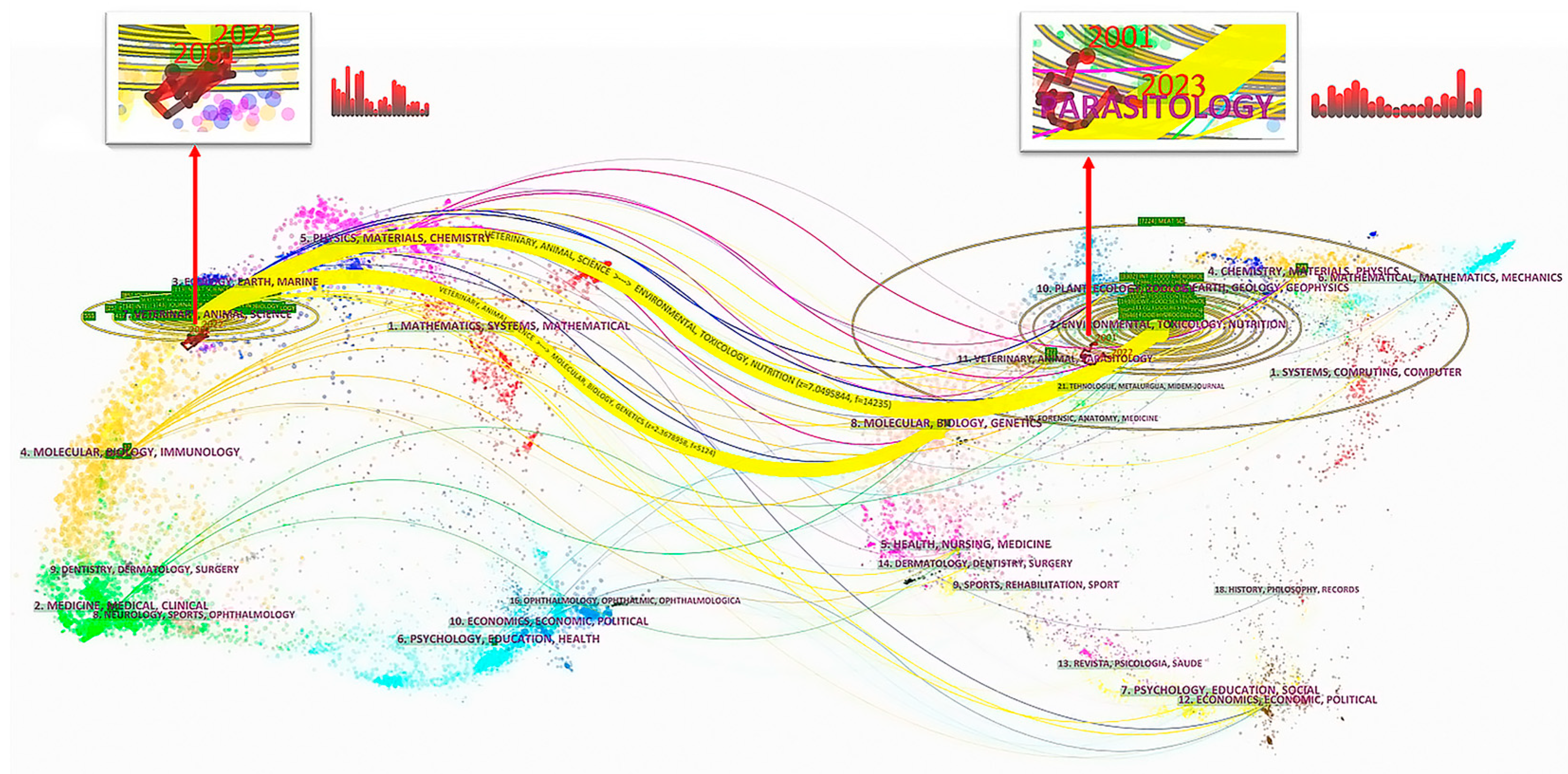
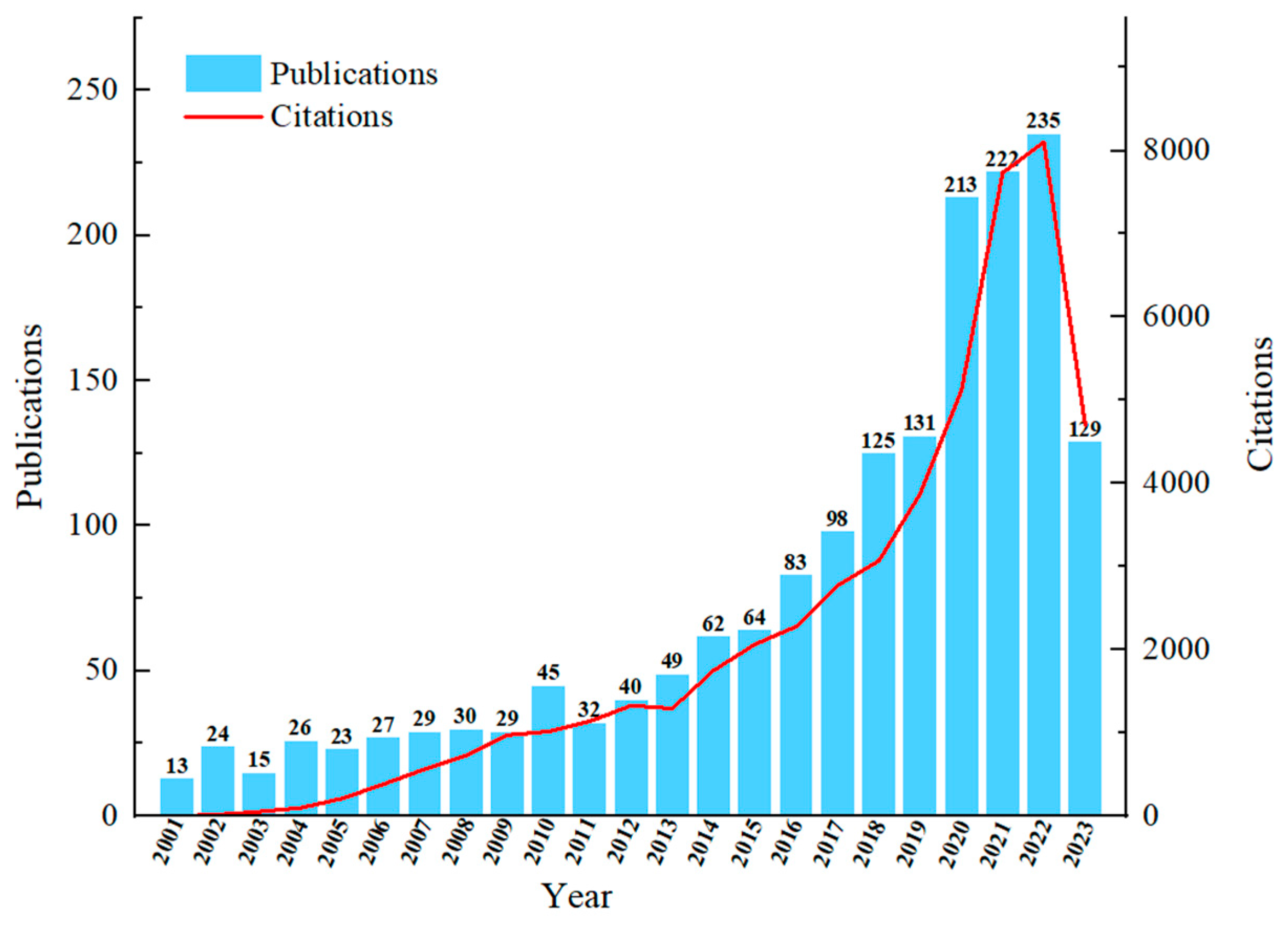
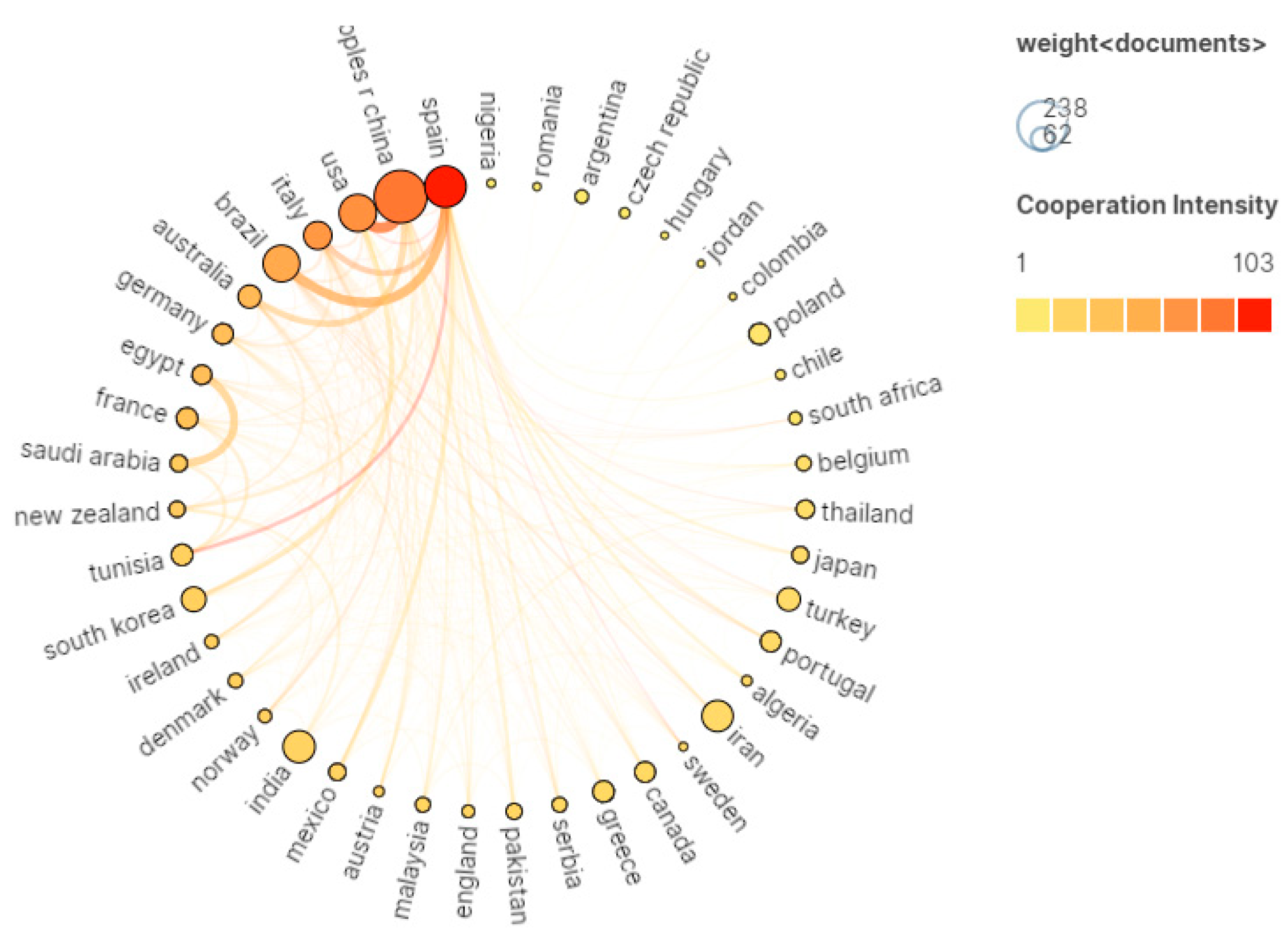


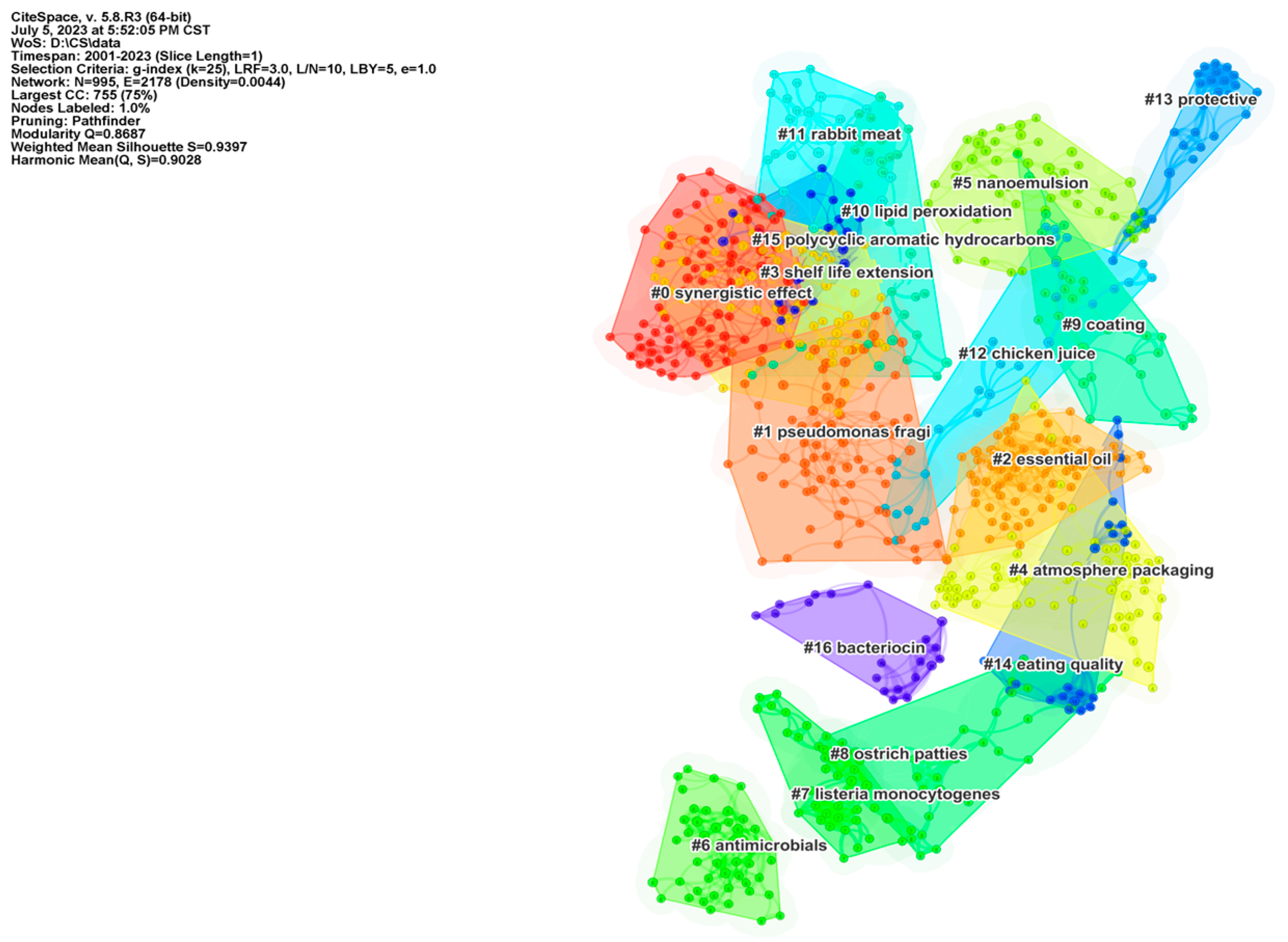
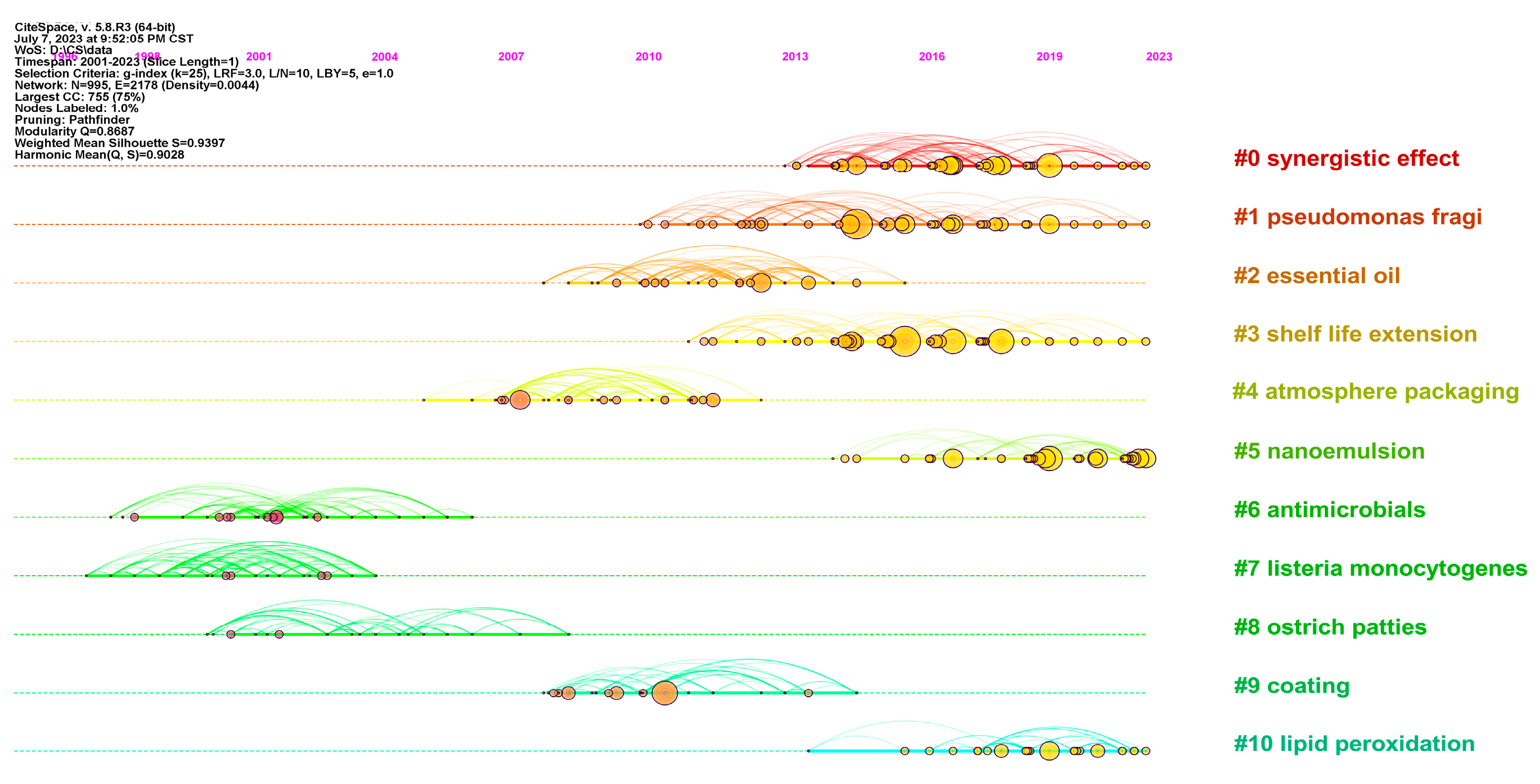
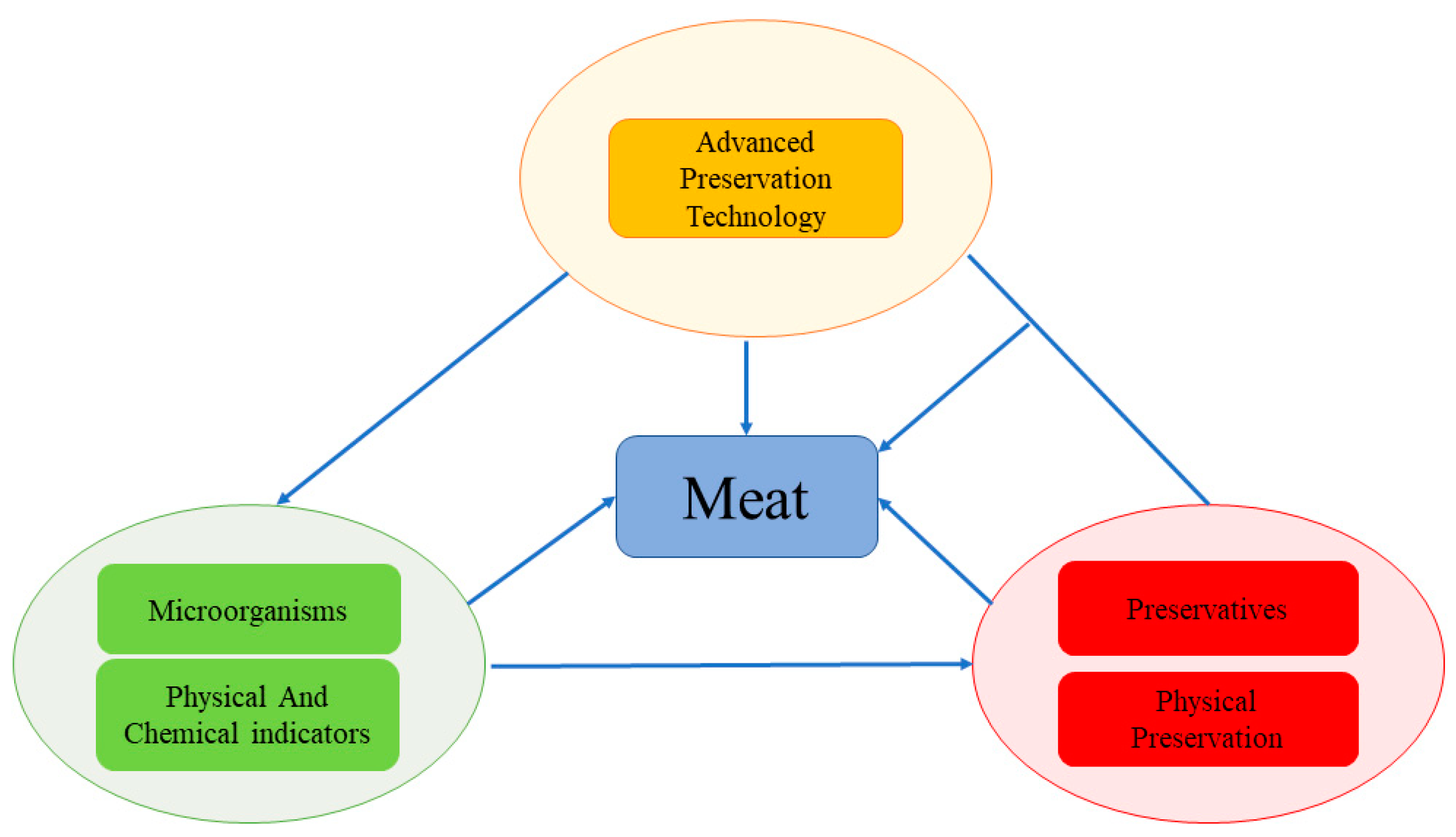
| High Publication Countries | High Publication Institutions | |||
|---|---|---|---|---|
| Rank | Country | N (%) | Institution | N (%) |
| 1 | Peoples R China | 238 (17.02%) | Egyptian Knowledge Bank | 34 (2.43%) |
| 2 | Spain | 153 (10.94%) | Nanjing Agricultural University | 29 (2.07%) |
| 3 | USA | 124 (8.87%) | Universidade De Sao Paulo | 28 (2.00%) |
| 4 | Brazil | 120 (8.58%) | Spanish National Research Council | 26 (1.86%) |
| 5 | India | 92 (6.58%) | Indian Council of Agricultural Research | 24 (1.86%) |
| 6 | Iran | 87 (6.22%) | CTR Tecnol Carne Galicia | 21 (1.50%) |
| 7 | Italy | 70 (5.01%) | National Research Institute for Agriculture and Food | 19 (1.36%) |
| 8 | South Korea | 54 (3.86%) | Islamic Azad University | 19 (1.36%) |
| 9 | Turkey | 48 (3.43%) | United States Department of Agriculture | 18 (1.29%) |
| 10 | Australia | 47 (3.36%) | Universidade Estadual De Campinas | 17 (1.29%) |
| High Publication Journals | |||||
|---|---|---|---|---|---|
| Rank | Journal | IF | Quartile | N (%) | Discipline |
| 1 | Meat Sci. | 7.1 | Q1 | 113 (8.08%) | Food Science and Technology |
| 2 | J. Food Process Pres. | 2.609 | Q4 | 85 (6.08%) | Food Science and Technology |
| 3 | LWT-Food Sci. Technol. | 6 | Q1 | 63 (4.51%) | Food Science and Technology |
| 4 | Food ControlONTROL | 6 | Q1 | 56 (4.01%) | Food Science and Technology |
| 5 | Foods | 5.2 | Q1 | 49 (3.51%) | Food Science and Technology |
| 6 | J. Food Sci. | 3.9 | Q2 | 43 (3.08%) | Food Science and Technology |
| 7 | J. Food Sci. Tech. Mys. | 3.1 | Q3 | 38 (2.72%) | Food Science and Technology |
| 8 | J. Food Process Pres. | 2.609 | Q4 | 37 (2.65%) | Food Science and Technology |
| 9 | Food Chem. | 8.8 | Q1 | 36 (2.58%) | Food Science and Technology |
| 10 | Int. J. Food Microbiol. | 5.4 | Q1 | 34 (2.43%) | Food Science and Technology |
| Citing Papers | Cited Papers | |||
|---|---|---|---|---|
| Cluster | Coverage % | Author | Author | Frequency |
| 0, 3 | 24 | Umaraw et al. [40] | Bazargani et al. [41] | 20 |
| 16 | Pateiro et al. [42] | Zhang et al. [43] | 17 | |
| 15 | Horita et al. [44] | Falowo et al. [45] | 16 | |
| 1, 7 | 15 | Ji et al. [46] | Krishnan et al. [47] | 19 |
| 14 | Zhu et al. [48] | Casaburi et al. [49] | 15 | |
| 15 | Gullón et al. [50] | Shah et al. [51] | 14 | |
| 2, 5 | 11 | Patel et al. [52] | Noori et al. [53] | 19 |
| 10 | Sánchez et al. [54] | Xiong et al. [55] | 18 | |
| 9 | Liu et al. [56] | Pabast et al. [57] | 16 | |
| 6, 16 | 16 | Shen et al. [58] | Samelis et al. [59] | 9 |
| 15 | Galvez et al. [60] | Mbandi et al. [61] | 8 | |
| 13 | Luchansky et al. [62] | Stekelenburg et al. [63] | 8 | |
| 4, 9 13, 14 | 17 | Simonin et al. [64] | Zhou et al. [8] | 21 |
| 13 | Duranton et al. [65] | Karabagias et al. [66] | 11 | |
| 12 | Olaoye et al. [67] | Chouliara et al. [68] | 11 | |
| 12 | Olaoye et al. [69] | Esmer et al. [70] | 7 | |
| 12 | Aymerich et al. [71] | Zhang et al. [72] | 7 | |
| 8, 11 12 | 11 | Velázquez et al. [73] | Dominguez et al. [74] | 22 |
| 11 | Carvalho et al. [75] | Lorenzo et al. [76] | 13 | |
| 10 | Alirezalu et al. [77] | Munekata et al. [46] | 11 | |
| 9 | Munekata et al. [78] | Ahmed et al. [79] | 11 | |
| 10, 15 | 13 | Liang et al. [80] | Dominguez et al. [81] | 15 |
| 12 | Bekhit et al. [82] | Fan et al. [83] | 12 | |
| 11 | Bekhit et al. [84] | Duran et al. [85] | 10 | |
| DOI | Cluster ID | Duration in 2001–2022 | Article Type | Theme |
|---|---|---|---|---|
| 10.1016/j.meatsci.2010.04.033 | 9 |  | Review | Review of meat preservation technology [8] |
| 10.1016/j.ijfoodmicro.2013.11.011 | 1 |  | Journal article | Application of plant extracts in chicken meat [47] |
| 10.3390/antiox8100429 | 11 |  | Review | Review of lipid oxidation in meat [45] |
| 10.1016/j.foodres.2014.06.022 | 0 |  | Review | Classification of natural antioxidants for meat [63] |
| 10.1016/j.fm.2006.12.005 | 4 |  | Journal article | Application of essential oil [68] |
| 10.1016/j.foodcont.2017.08.015 | 5 |  | Journal article | Application of coatings based on nanoemulsions [53] |
| 10.1016/j.lwt.2014.04.061 | 3 |  | Journal article | Application of active packaging [93] |
| 10.1016/j.tifs.2013.09.002 | 2 |  | Review | Review of the effect of essential oils [56] |
| 10.3389/fmicb.2012.00012 | 2 |  | Review | Application of essential oils [94] |
| 10.1016/j.ifset.2015.04.007 | 3 |  | Journal article | Synergistic effect of essential [41] |
| DOI | Cluster ID | Duration in 2001–2022 | Article Type | Theme |
|---|---|---|---|---|
| 10.1016/j.foodres.2018.07.014 | 0 |  | Review | Application of essential oils in meat preservation [95] |
| 10.1371/journal.pone.0160535 | 0 |  | Journal article | Application of essential-oil-coated film [96] |
| 10.3390/antiox8100429 | 11 |  | Review | Review of lipid oxidation in meat [74] |
| 10.1016/j.foodcont.2017.08.015 | 5 |  | Journal article | Application of coatings based on nanoemulsions [53] |
| 10.1016/j.foodcont.2018.03.047 | 5 |  | Journal article | Application of coatings based on nanoemulsions [57] |
| 10.1016/j.meatsci.2016.03.002 | 0 |  | Journal article | Application of essential oils in meat preservation [97] |
| 10.1016/j.foodres.2018.06.073 | 10 |  | Review | Loaded essential oil films for meat applications [81] |
| 10.1016/j.ijfoodmicro.2016.08.042 | 5 |  | Journal article | Synergistic effect of essential oils [98] |
| 10.1016/j.cofs.2020.03.003 | 11 |  | Review | Addition of plant extracts to meat [78] |
| 10.1016/j.foodcont.2019.106771 | 5 |  | Journal article | Application of composite nanoemulsions coating [90] |
| 10.1016/j.meatsci.2018.08.022 | 10 |  | Journal article | Application of plant extracts [83] |
| 10.1016/j.foodcont.2019.02.013 | 5 |  | Journal article | Synergistic effect of gases and biopreservatives [89] |
Disclaimer/Publisher’s Note: The statements, opinions and data contained in all publications are solely those of the individual author(s) and contributor(s) and not of MDPI and/or the editor(s). MDPI and/or the editor(s) disclaim responsibility for any injury to people or property resulting from any ideas, methods, instructions or products referred to in the content. |
© 2023 by the authors. Licensee MDPI, Basel, Switzerland. This article is an open access article distributed under the terms and conditions of the Creative Commons Attribution (CC BY) license (https://creativecommons.org/licenses/by/4.0/).
Share and Cite
Zhang, J.; Wei, Z.; Lu, T.; Qi, X.; Xie, L.; Vincenzetti, S.; Polidori, P.; Li, L.; Liu, G. The Research Field of Meat Preservation: A Scientometric and Visualization Analysis Based on the Web of Science. Foods 2023, 12, 4239. https://doi.org/10.3390/foods12234239
Zhang J, Wei Z, Lu T, Qi X, Xie L, Vincenzetti S, Polidori P, Li L, Liu G. The Research Field of Meat Preservation: A Scientometric and Visualization Analysis Based on the Web of Science. Foods. 2023; 12(23):4239. https://doi.org/10.3390/foods12234239
Chicago/Turabian StyleZhang, Jingjing, Zixiang Wei, Ting Lu, Xingzhen Qi, Lan Xie, Silvia Vincenzetti, Paolo Polidori, Lanjie Li, and Guiqin Liu. 2023. "The Research Field of Meat Preservation: A Scientometric and Visualization Analysis Based on the Web of Science" Foods 12, no. 23: 4239. https://doi.org/10.3390/foods12234239
APA StyleZhang, J., Wei, Z., Lu, T., Qi, X., Xie, L., Vincenzetti, S., Polidori, P., Li, L., & Liu, G. (2023). The Research Field of Meat Preservation: A Scientometric and Visualization Analysis Based on the Web of Science. Foods, 12(23), 4239. https://doi.org/10.3390/foods12234239







